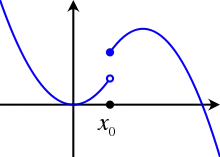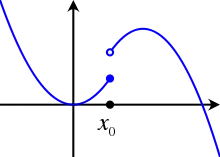Semi-continuity
In mathematical analysis, semi-continuity (or semicontinuity) is a property of extended real-valued functions that is weaker than continuity. An extended real-valued function is upper (respectively, lower) semi-continuous at a point if, roughly speaking, the function values for arguments near are not much higher (respectively, lower) than
A function is continuous if-and-only-if it is both upper- and lower-semicontinuous. If we take a continuous function and increase its value at a certain point to (for some positive constant ), then the result is upper-semicontinuous; if we decrease its value to then the result is lower-semicontinuous.
Formal definition
Suppose is a topological space, is a point in and is an extended real-valued function.
The function is said to be upper semi-continuous at if for every there exists a neighborhood of such that for all when and tends to as tends towards when
For the particular case of a metric space, this can be expressed as
where lim sup is the limit superior (of the function at point ). (For non-metric spaces, an equivalent definition using nets may be stated.)
The function is called upper semi-continuous if it is upper semi-continuous at every point of its domain.
The function is said to be lower semi-continuous at if for every there exists a neighborhood of such that for all in when , and tends to as tends towards when .
Equivalently, in the case of a metric space, this can be expressed as
where is the limit inferior of the function at point
The function is called lower semi-continuous if it is lower semi-continuous at every point of its domain.
Lower level sets are also called sublevel sets or trenches.[1]
Characterizations
A function is upper semi-continuous (resp. lower semi-continuous) if and only if (resp. ) is an open set for every Alternatively, a function is lower semi-continuous if and only if all of its lower level sets are closed. A function is lower semicontinuous if and only if is upper semicontinuous.[2]
A function is lower semicontinuous if and only if its epigraph (the set of points lying on or above its graph) is closed.
A function from some topological space is lower semicontinuous if and only if it is continuous with respect to the Scott topology on
Because is a subbasis for the Euclidean topology on a function is continuous if and only if and are open for every This characterization can be seen as motivating the definitions of upper and lower semicontinuity.[2] Moreover, a function is continuous at if and only if it is both upper and lower semi-continuous there.[2] Therefore, semi-continuity can be used to prove continuity.
Examples

Consider the function piecewise defined by:
This function is upper semi-continuous at but not lower semi-continuous.

The indicator function of a closed set is upper semi-continuous, whereas the indicator function of an open set is lower semi-continuous. The floor function , which returns the greatest integer less than or equal to a given real number is everywhere upper semi-continuous. Similarly, the ceiling function is lower semi-continuous.
A function may be upper or lower semi-continuous without being either left or right continuous. For example, the function
is upper semi-continuous at , since its value there is higher than its value in its neighborhood. However, it is neither left nor right continuous: The limit from the left is equal to 1 and the limit from the right is equal to 1/2, both of which are different from the function value of 2. If is modified e.g. by setting then it is lower semi-continuous
Similarly the function
is upper semi-continuous at while the function limits from the left or right at zero do not even exist.
If is a Euclidean space (or more generally, a metric space) and is the space of curves in (with the supremum distance then the length functional which assigns to each curve its length is lower semicontinuous.
The indicator function of any open set is lower semicontinuous. The indicator function of a closed set is upper semicontinuous. However, in convex analysis, the term "indicator function" often refers to the characteristic function, and the characteristic function of any closed set is lower semicontinuous, and the characteristic function of any open set is upper semicontinuous.
Let be a measure space and let denote the set of positive measurable functions endowed with the topology of convergence in measure with respect to . Then by Fatou's lemma the integral, seen as an operator from to is lower semi-continuous.
Sufficient conditions
If and are two real-valued functions which are both upper semi-continuous at then so is If both functions are non-negative, then the product function will also be upper semi-continuous at The same holds for functions lower semi-continuous at [3]
The composition of upper semi-continuous functions and is not necessarily upper semi-continuous, but if is also non-decreasing, then is upper semi-continuous.[4]
Multiplying a positive upper semi-continuous function with a negative number turns it into a lower semi-continuous function.
Suppose is a lower semi-continuous function for every index in a nonempty set and define as pointwise supremum; that is,
- for every
Then is lower semi-continuous.[5][2] Even if all the are continuous, need not be continuous; indeed, every lower semi-continuous function on a uniform space (e.g. a metric space) arises as the supremum of a sequence of continuous functions. Likewise, the pointwise infimum of an arbitrary collection of upper semicontinuous functions is upper semicontinuous.
Suppose are non-negative lower semi-continuous functions indexed by such that for every Then is lower semicontinuous.[2] If in addition every is continuous, then is necessarily continuous.[2]
The maximum and minimum of finitely many upper semicontinuous functions is upper semicontinuous, and the same holds true of lower semicontinuous functions.
Properties
If is a compact space (for instance a closed, bounded interval ) and is upper semi-continuous, then has a maximum on The analogous statement for (–∞,∞]-valued lower semi-continuous functions and minima is also true. (See the article on the extreme value theorem for a proof.)
Any upper semicontinuous function on an arbitrary topological space is locally constant on some dense open subset of
See also
- Continuous function – Mathematical function with no sudden changes in value
- Directional continuity
- Semicontinuous multivalued function
References
- Kiwiel, Krzysztof C. (2001). "Convergence and efficiency of subgradient methods for quasiconvex minimization". Mathematical Programming, Series A. 90 (1). Berlin, Heidelberg: Springer. pp. 1–25. doi:10.1007/PL00011414. ISSN 0025-5610. MR 1819784.
- Muger, Michael (2020). Topology for the Working Mathematician. pp. 93–94.
- Puterman, Martin L. (2005). Markov Decision Processes Discrete Stochastic Dynamic Programming. Wiley-Interscience. pp. 602. ISBN 978-0-471-72782-8.
- Moore, James C. (1999). Mathematical methods for economic theory. Berlin: Springer. p. 143. ISBN 9783540662358.
- "Baire theorem". Encyclopedia of Mathematics.
Further reading
- Benesova, B.; Kruzik, M. (2017). "Weak Lower Semicontinuity of Integral Functionals and Applications". SIAM Review. 59 (4): 703–766. arXiv:1601.00390. doi:10.1137/16M1060947.
- Bourbaki, Nicolas (1998). Elements of Mathematics: General Topology, 1–4. Springer. ISBN 0-201-00636-7.
- Bourbaki, Nicolas (1998). Elements of Mathematics: General Topology, 5–10. Springer. ISBN 3-540-64563-2.
- Gelbaum, Bernard R.; Olmsted, John M.H. (2003). Counterexamples in analysis. Dover Publications. ISBN 0-486-42875-3.
- Hyers, Donald H.; Isac, George; Rassias, Themistocles M. (1997). Topics in nonlinear analysis & applications. World Scientific. ISBN 981-02-2534-2.
